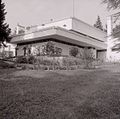Vico Magistretti
Vico Magistretti | |
|---|---|
 | |
| Born | October 6, 1920 |
| Died | September 19, 2006 (aged 85) |
| Nationality | Italian |
| Alma mater | Politecnico di Milano |
| Occupation | Architect |
| Awards | Gold Medal at the 1951 Triennale, Grand Prix at the 1954 Triennale, two Compasso d'Oro awards in 1967 and 1979, the Gold Medal of the Chartered Society of Industrial Artists & Designers in 1986 |
| Practice | furniture designer and architect |
| Buildings | QT8 Church[1] |
Vico Magistretti (October 6, 1920 – September 19, 2006) was an Italian industrial designer, known as a furniture designer and architect.[1] A collaborator of humanist architect Ernesto Nathan Rogers, one of Magistretti's first projects was the "poetic" round church in the experimental Milan neighborhood of QT8.[1] He later designed mass-produced appliances and furniture for companies such as Cassina S.p.A.,[1] and won several awards, including the Gold Medal of the Chartered Society of Industrial Artists & Designers in 1986.[1]

Early life, education[]


Vico Magistretti was born on October 6, 1920 in Milan, Italy. He was the son of an architect.[1] During the second world war, to avoid being deported to Germany, on September 8, 1943 he left Italy during his military service and moved to Switzerland.[2] While in the country he taught at the local university and took courses at the Champ Universitaire Italien in Lausanne.[2]
While in Switzerland he met Ernesto Nathan Rogers, who turned out to be his maestro.[2] According to The Guardian, "He soon came under the influence of the architect Ernesto Nathan Rogers, whose humanist ideas for the reconstruction of postwar Italy inspired a whole series of intellectuals. At that time Magistretti took part in work on the extraordinary experimental neighbourhood on the edge of Milan known as QT8, where a group of architects and planners were given complete freedom. Magistretti built its "poetic" round church."[1]
He returned to Milan in 1945,[2] graduating from the Politecnico di Milano University in 1945.[1]
Production career[]
After graduation he worked at the firm owned by his father, Pier Giulio, with the architect Paolo Chessa.[2]
He worked initially in urban design in Milan. In the 1950s he moved into the field of mass-produced furniture and lamps. Some became museum pieces. Among other, he worked for the following companies: Artemide, Cassina, De Padova, Flou, Fritz hansen, Kartell, Schiffini.[citation needed]
According to The Guardian, "His first great success came with the world famous Carimate chair produced by the Cassina company. The chair was a bestseller for years and mixed rural simplicity (the straw of the seat) with urban sophistication. There were the smooth lines of the wooden supports and legs, the colour, the pop-art bright red frame and elements of Scandinavian design."[1]
- Architectures by Magistretti in Lombardy (Italy) photographed by Paolo Monti

Building in corso Europa 22, Milan (1955-1957), detail

Villa Arosio, Arenzano (1958): interiors

Building in via Leopardi, Milan (with Guido Veneziani), 1961

Carimate Golf club (with Guido Veneziani)

Milan, tower house in piazzale Aquileia 8, 1964-1965
Museum exhibits[]
Magistretti's works have been shown in the most important international museums in Europe, USA, and Japan. Some have also been included in various permanent exhibitions museums such as MoMa.[1]
Awards[]
Vico Magistretti received many awards, among which: the Gold Medal at the 1951 Triennale, the Grand Prix at the 1954 Triennale, two Compasso d'Oro awards in the years 1967 and 1979 as well as the Gold Medal of the Chartered Society of Industrial Artists & Designers in 1986.[1]
| Year | Award | Nominated work | Category | Result |
|---|---|---|---|---|
| 1951 | Triennale | Magistretti | Gold Medal | |
| 1954 | Triennale | Magistretti | Grand Prix | |
| 1967 | Compasso d'Oro | Magistretti | Won | |
| 1979 | Compasso d'Oro | Magistretti | Won | |
| 1986 | Chartered Society of Industrial Artists & Designers | Magistretti | Gold Medal |
Affiliations and fellowships[]
He taught for 20 years at the Royal College of Arts in London, and was nominated as a royal designer.[1] He also taught at Domus Academy in Milan, and has also been an honorary member of the Royal Scottish Incorporation of Architects.
Personal life, death[]
Magistretti's wife Paola died in 1998. He died on September 19, 2006, and was survived by his son, Stefano, and daughter, Susanna.[1] His legacy is overseen by the Vico Magistretti Foundation.[3]
Gallery[]

Carimate Chair Back 1959

Eclisse lamp 1965

Eclisse lamp 1965

Oluce lamp 1977

Chaise Longue 1996
References[]
This article needs additional citations for verification. (May 2014) |
External links[]
| Wikimedia Commons has media related to Vico Magistretti. |
- 1920 births
- 2006 deaths
- 20th-century Italian architects
- Italian industrial designers
- Polytechnic University of Milan alumni










